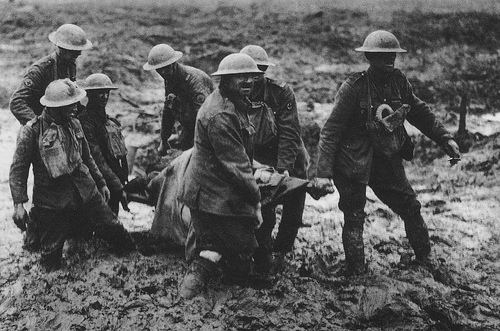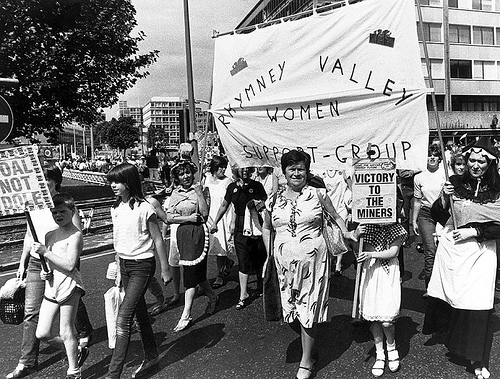As politicians prepare a ‘celebration’ of the First World War, Bill Scott looks at a song which remembers the horrors of the trenches.
Green Fields of France
Words & Music: Eric Bogle
Well, how’d you do, Private Willie McBride,
D’you mind if I sit down down here by your graveside?
I’ll rest for awhile in the warm summer sun,
Been walking all day, Lord, and I’m nearly done.
I see by your gravestone you were only 19
When you joined the glorious fallen in 1916,
I hope you died quick and I hope you died clean,
Or, Willie McBride, was it slow and obscene?
CHORUS: Did they beat the drum slowly, did they sound the fife lowly?
Did the rifles fire o’er ye as they lowered ye down?
Did the bugles sing “The Last Post” in chorus?
Did the pipes play the “Floors O’ The Forest”?
And did you leave a wife or a sweetheart behind
In some faithful heart is your memory enshrined?
And, though you died back in 1916,
To that loyal heart are you forever nineteen?
Or are you a stranger, without even a name,
Forever enshrined behind some glass pane,
In an old photograph, torn and tattered and stained,
And fading to yellow in a brown leather frame?
CHORUS
Well, the sun’s shining down on these green fields of France;
The warm wind blows gently, the red poppies dance.
The trenches have vanished long under the plow;
No gas and no barbed wire, no guns firing now.
But here in this graveyard it’s still No Man’s Land;
The countless white crosses in mute witness stand
To man’s blind indifference to his fellow man.
And a whole generation who were butchered and damned.
CHORUS
And I can’t help but wonder now, Willie McBride
Do all those who lie here know why they died?
Did you really believe them when they told you “the cause?”
Did you really believe that this war would end wars?
Well the suffering, the sorrow, the glory, the shame,
The killing, the dying, it was all done in vain,
For Willie McBride, it’s all happened again,
And again, and again, and again, and again.
CHORUS
David Cameron is planning a “celebration” of the First World War next year on the centenary of its start in 1914. For once we can all agree with Establishment cynic Jeremy Paxman that this demonstrates once and for all that Cameron is “a complete idiot”. What next? A celebration of the anniversary of the Black Death’s arrival in Europe?
The truth is that the First World War was one of history’s greatest tragedies – the sacrifice of a generation of, mainly, European young men at the altar of imperialist hubris with absolutely no underlying redeeming rationale. The causes of the Great War were not an assassination in Serbia but an ever escalating arms race by all of the “Great Powers” coupled with an imperialist lust for more land, resources and power that could only ever have had one outcome.
In the first three months of the war the ‘Allies’ (Britain, France, Russia) suffered a million casualties. By the spring of 1915 both sides were bogged down in trench warfare on the Western Front, the muddy and bloody fields of Flanders.
The military commands of both sides were employing the tactics of a mid-19th century war with troops armed with 20th century weaponry. Yet it had been evident since the time of the American Civil War, some 50 years earlier, that sending masses of men across open ground against well defended positions would simply lead to massive casualties. Since that time barbed wire, machine guns and quick loading rifles had made the already costly tactic of frontal assault a suicidal one – but still the old duffers in overall command, safely sited miles from the front where the actual fighting was done, commanded their troops to “go over the top”.
The Battle of the Somme, where “Willie McBride” most probably fell, epitomises the horror and futility of trench warfare. The Battle started in July 1st 1916 and lasted until November of that year. Douglas Haig the British commander had come up with the battle plan to relieve the pressure on the French army which had suffered horrific casualties of its own, and was on the point of mutiny, after the German “Spring offensive” at Verdun.
Now Haig intended to prove that Britain was as prepared as Germany or France to sacrifice its young men’s lives for the sake of national pride. On the first day of the battle the British suffered 60,000 casualties – probably more than all the casualties that the British army has incurred in the near 70 years since the end of the Second World War. By the end of the battle, the British Army had suffered 420,000 casualties. The French lost another 200,000 men and the Germans nearly 500,000. The gains – at the end of the Battle the Allies had advanced just over 6 miles from where they had started at a collective cost of 200,000 young men for each mile of the advance. Yet the Somme marked only the mid-point of the First World War. Another 2 years of useless slaughter were still to come.
The First World War may seem like ancient history today nearly a century later, but its impact on people’s view of the world and on Scotland itself is still being felt. The sheer scale of the slaughter is staggering. There were over 37 million casualties (military and civilian) directly attributable to the war with over 15 million deaths and 22 million wounded. This includes almost 9 million military deaths and about 6.6 million civilian deaths.
The support to their home countries’ involvement in the war given by the Labour Party (and other social democratic parties in Europe ) split the socialist left. Throughout Europe a few principled socialists stood out – in Scotland, McLean, in Ireland, Connolly, in Germany, Luxemburg & Liebnecht and in Russia Lenin & Trotsky. All suffered for their beliefs and activity – in prison, exile or death. However as the scale of the slaughter became clear many of those in the working class who had at first supported the war were sickened by it and began to resist its continuance. This opposition to the war led to the Easter Rising, Red Clydeside, the Russian Revolution and the German Army’s mutiny - which effectively ended the war.
The impact of the First Word War in Scotland was profound. A total of 147,609 Scots were killed during World War One. That means that a fifth of all Britain’s war dead came from a nation that made up only 10% of its population. In total, when including the maimed and wounded, Scotland suffered a quarter of all British casualties. That’s more dead and wounded per head of population than any other country involved in WW I other than Turkey & Serbia - which were actual theatres of war where land armies clashed and civilians became caught up in the fighting.
Scotland was a country in mourning in the aftermath of the war. Its steady population growth throughout the 19th and early 20th centuries, which had taken place despite the Clearances, was halted and reversed. Virtually no Scots family was left untouched by loss and the massive outpouring of grief that the Great War occasioned is captured in stone in the National War Memorial which was built in Edinburgh Castle. Visit it and read the seemingly unending list of the names of the fallen and weep at the absolute waste of human lives and national potential. Scotland has had no difficulty in remembering the fallen of the First World War but perhaps David Cameron should be careful that he doesn’t stir up memories of the unfairness of the scale of our needless sacrifice when compared to other parts on the “United” Kingdom. In WWI, 27% of Scottish troops mobilised were killed, compared to 12% for British forces overall. One might ask why that difference exists. It couldn’t have been because Scots troops were seen as more expendable by the British High Command, could it?
This song was written by one of Scotland’s greatest exports Eric Bogle, the folk singer and writer now located in Australia. It sits alongside another of his compositions, “Waltzing Matilda”, as one of the great anti-war songs set in the aftermath of World War I. Read Sebastian Faulks’ “Birdsong” to get a picture of the living hell that was the Somme and if you can try to catch a screening of “Joyeux Noel” this Christmas. Based on real incidents it captures the camaraderie of Scots, German and French troops during the unofficial Christmas truce that broke out in the trenches in 1914 and the efforts that the military command made to crush the truce and its memory. It’s a true commemoration of an unnecessary tragedy rather than a grotesque celebration of an immense bloodbath.






